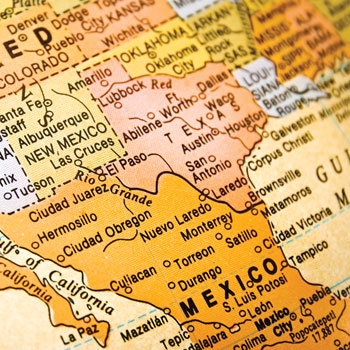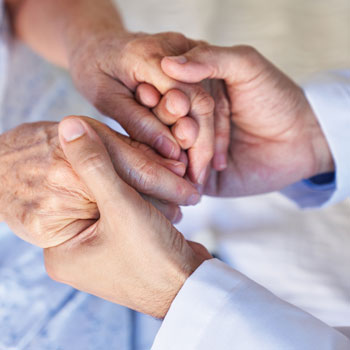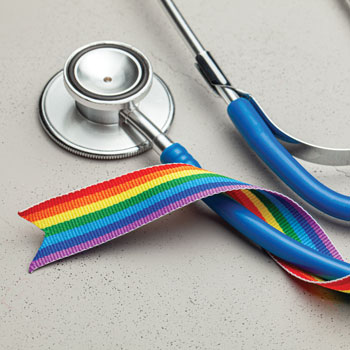IM physicians join health inspections at the border
Two ACP members toured Customs and Border Protection (CBP) facilities near the Texas/Mexico border to evaluate the processes and environmental conditions affecting human health at the facilities.
It was not a typical day of practicing internal medicine. On June 15, 2022, two ACP members joined a group of physicians and government officials on a tour of two U.S. Customs and Border Protection (CBP) facilities near the Texas/Mexico border.
The purpose of the visit was to evaluate the processes and environmental conditions affecting human health at the facilities, where people seeking asylum in the U.S. are held for up to three days. Pediatricians concerned about the welfare of children at the facilities were the driving force behind the visit, and they invited representatives from the College along to assess the situation as well.

Two answered the call: Ruth Berggren, MD, MACP, director of the Center for Medical Humanities & Ethics at UT Health San Antonio and Immediate Past President for the Texas ACP Chapter, and Elena Jiménez Gutiérrez, MD, MSc, FACP, a hospitalist at UT Health San Antonio. ACP Internist spoke to them about the experience.
Q: What in your background led you to be part of this visit?
A: Dr. Berggren: This is an area that I care a lot about. We have six student-run free clinics that operate under the umbrella of the center which I direct, and one of our populations is refugees. So I had a real vested interest in wanting to make this happen and do my duty for ACP.
Dr. Jiménez Gutiérrez: I'm a volunteer member of the Physicians for Human Rights Asylum Network, which means I perform forensic medical evaluations on asylum seekers to examine the evidence of past persecution and abuse or ill treatment. Then I became a board member of Project Lifeline, an organization that fights for justice and freedom for undocumented and immigrant children through legal and medical legal initiatives, strategic partnerships, and targeted advocacy. And I got involved with Doctors for Camp Closure, which is another organization that is advocating for closure of detention centers for asylum seekers.
Q: Where did your visit take you?
A: Dr. Berggren: The first [detention center] was in McAllen proper and it is called Ursula [for the street it's on]. Then we visited 20 minutes away, in the town of Donna, Texas, a second facility, a soft-walled facility that was initially supposed to be temporary but it's becoming permanent. Ursula is right now for adults, and Donna is for unaccompanied children as well as families, which basically means mothers and children, as we found out, but a surprising number of unaccompanied children.
One of the first things they said to us was unaccompanied children are only 15% of our CBP apprehensions, but the problem is the total number of asylum seekers is going up, up, up. The number of encounters by U.S. Border Patrol—300,000 in 2017—had grown to over 1.4 million by June 2022. So the fact that it's 15%, if the number is large and increasing, doesn't mean very much, because the absolute numbers are still pretty high.
Q: Why were these facilities in particular important to visit?
A: Dr. Berggren: Remember we were seeing images of children in cages? The CBP facility in McAllen is a refitted warehouse. They started renovating this facility in October 2020. Thirty million dollars later, they reopened in March of this year. So the question is, how did they do? There were other criticisms at that time … about the extremes of temperature, inadequate attention to child care, malnutrition, medical care, and infection control practices.
Q: What did you think of what you found?
A: Dr. Jiménez Gutiérrez: I was very shocked by the crowding … People in indoor sleeping areas just side by side on cold concrete floors. One of the most concerning things was the lack of hygiene practices. They showed us sinks and showers for handwashing and bathing, but the ratio of showers to people was quite disproportionate, and the showers that they showed us at Ursula did not seem to have been in use. They were completely dry. We saw many women and children emerging from showers in the Donna facility. … The temperature is now controlled; it's not too hot, not too cold, and the humidity level seems to be controlled as well as the CO2 concentration.
My other concern was they had open toilets within the same rooms where the asylum seekers were sleeping. For someone who has been assaulted in the past, and even someone who hasn't—I'm sure none of us would want to defecate in a room where 25 to 50 other people can see us. According to the Istanbul Protocol, which is a United Nations document that outlines international legal standards and sets out specific guidelines on how to document and conduct effective legal and medical investigations into allegations of torture and ill-treatment, certain conditions of detention, such as overcrowded cells, unhygienic conditions, and denial of privacy, are considered methods of ill-treatment.
Dr. Berggren: We were concerned that even though the facility was only about half full, we saw rooms where people were lying on the floor, pretty much six inches apart. … Even after the renovation, even on an uncrowded day, people are being subjected to being housed in conditions that are extremely stressful and far from ideal, and actually a bad idea from an infection control standpoint. Everybody's offered a mask, but if you're lying in a room with 50 people, windows aren't open, there's no way that you're not going to get COVID.
Q: What COVID-19 protocols were in place?
A: Dr. Berggren: They have Plexiglas, they have PPE, they have vaccination being offered at over 26 vaccine sites. They said there have been 45,000 vaccines that had been given, but I didn't know if that was year-to-date or cumulative. They were only doing COVID testing on unaccompanied children. Everybody comes in, they get their temperature checked, and if they're obviously sick, they get recognized and then they get referred. They do have a special CBP facility in another location, which is where people can get isolated. We did not see that facility.
Q: Did you see any examples of the medical care provided?
A: Dr. Berggren: The triage system looks like it's competent and appropriate and pretty robust. I think they're getting good training in how do you triage, how do you identify somebody that's sick. We witnessed a woman at the intake area at Ursula who collapsed. … There were four people from CBP that ran over to this woman and started administering first aid as she was vomiting.
A policy is that people who come in with medications, say for their diabetes or hypertension, have their medicines taken from them and replaced with U.S. medications, for safety reasons. It's like the hospital is not going to let you take the medicines that you bring from home. But when they leave, they're supposed to be given medications to go. We are learning in San Antonio that that's not happening with regularity. … We can describe cases where individuals were deprived of their anticoagulant, which was prescribed for a deep venous thrombosis, and then they get to San Antonio and their leg is swollen out to here.
Dr. Jiménez Gutiérrez: We've had multiple examples. This is just not one occurrence. And they said, “Well, it is difficult to assess. Sometimes people are just too traumatized to talk about their medications.” … They want to do a trauma-informed approach. Many, most, if not all of these asylum seekers have been traumatized, but that doesn't mean we cannot take the time for a good history about their medical conditions and medications.
Q: What are potential solutions?
A: Dr. Berggren: We suggested that [the government] might establish a portal, or a mechanism for communication, so that missed medical conditions or breaches in medical management could be reported back by medical personnel who care for migrants later during their journey. … One of the ways that I think ACP could advocate is to try to assist with a mechanism for documenting information about the outcomes and consequences of medical management during detention. As an example, we might be able to provide data about numbers of patients whose blood pressure or diabetes required urgent care or emergency treatment, as a consequence of leaving CBP custody without replacement medications. Only data can really help us get to the bottom of that. We communicated this in a spirit of contributing to process improvement, in the interest of protecting the health of asylum seekers.
Dr. Jiménez Gutiérrez: It appeared that CBP were amenable to having more of an avenue of communication with medical providers who are receiving some of their detainees to communicate the disruption in medical care … to have a feedback process in which they could fix some of those protocols. As individual internists we could specifically address it on a case-by-case basis and maybe [CBP would] even change their practices to abide by what their written protocol says.
Q: What else can ACP and its members do to help?
A: Dr. Berggren: We need to train our physicians better in how to bear witness to what's happening to our patients in ways that don't compromise our standards of confidentiality, because there are ways to do that. I also feel like we could do a better job of training physicians in methods for advocacy.
I've cowritten an opinion piece in the journal Health Affairs decrying the effect of Title 42 [which gave the CDC the power to close the border during the pandemic] on children. We need to get smarter about our policies, and in my view, we need to make it easier for families to stay together. Separating breadwinners from the rest of the families is not a good strategy.
Dr. Jiménez Gutiérrez: I think ACP is doing great work on many fronts. Approved by the ACP Board of Regents on April 25, 2022, the Position Statement on Increasing Access to Healthcare for Non-Detained Asylum Seekers declares “ACP supports research into the medical needs of non-detained asylum seekers living in the United States as well as their current access to medical care, the health effects of detention versus non-detention for asylum seekers, and alternatives to detention that connect asylum seekers to health care, legal, and other services” (see sidebar). I advocate for us to join our colleagues at the [American Academy of Pediatrics] and [American Academy of Family Physicians] to make a stronger statement against detention and ill treatment of asylum-seeking individuals and families. … Humane treatment of them should not be a question of politics.




